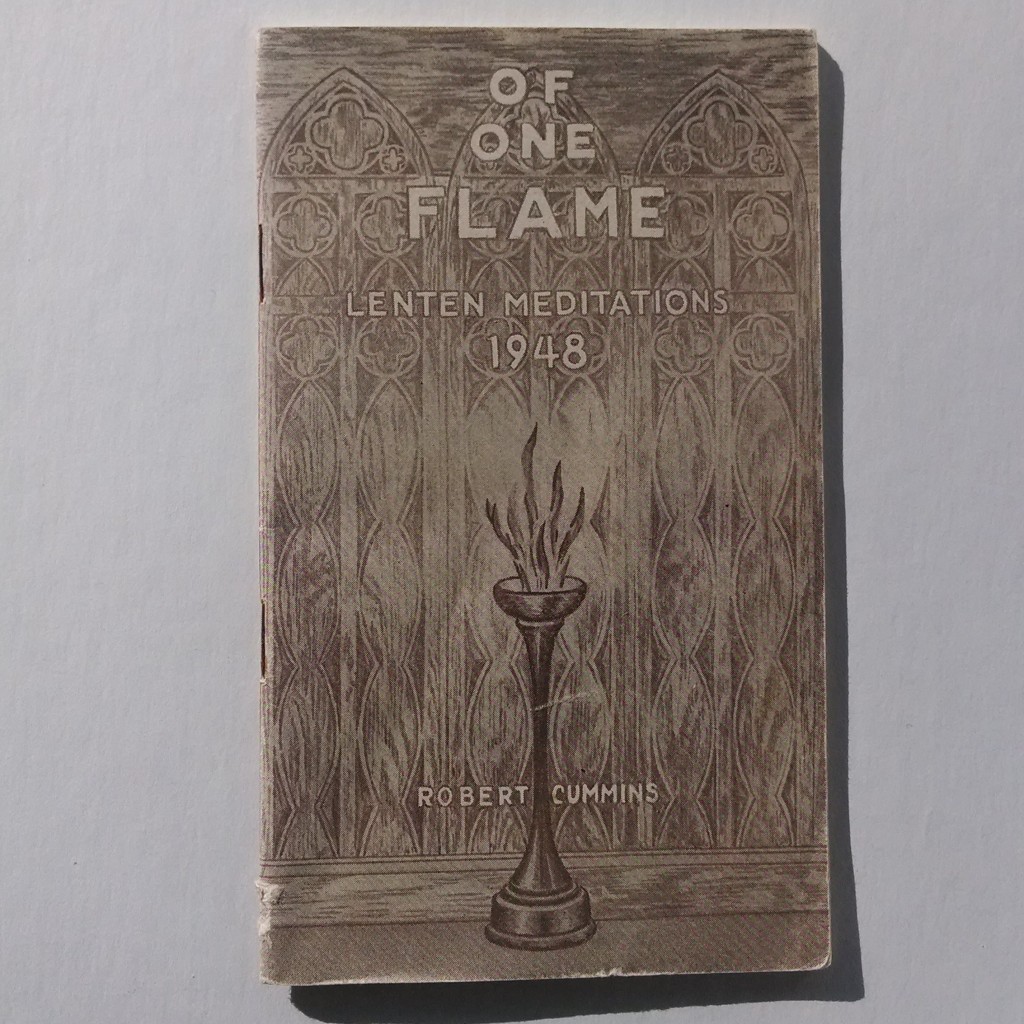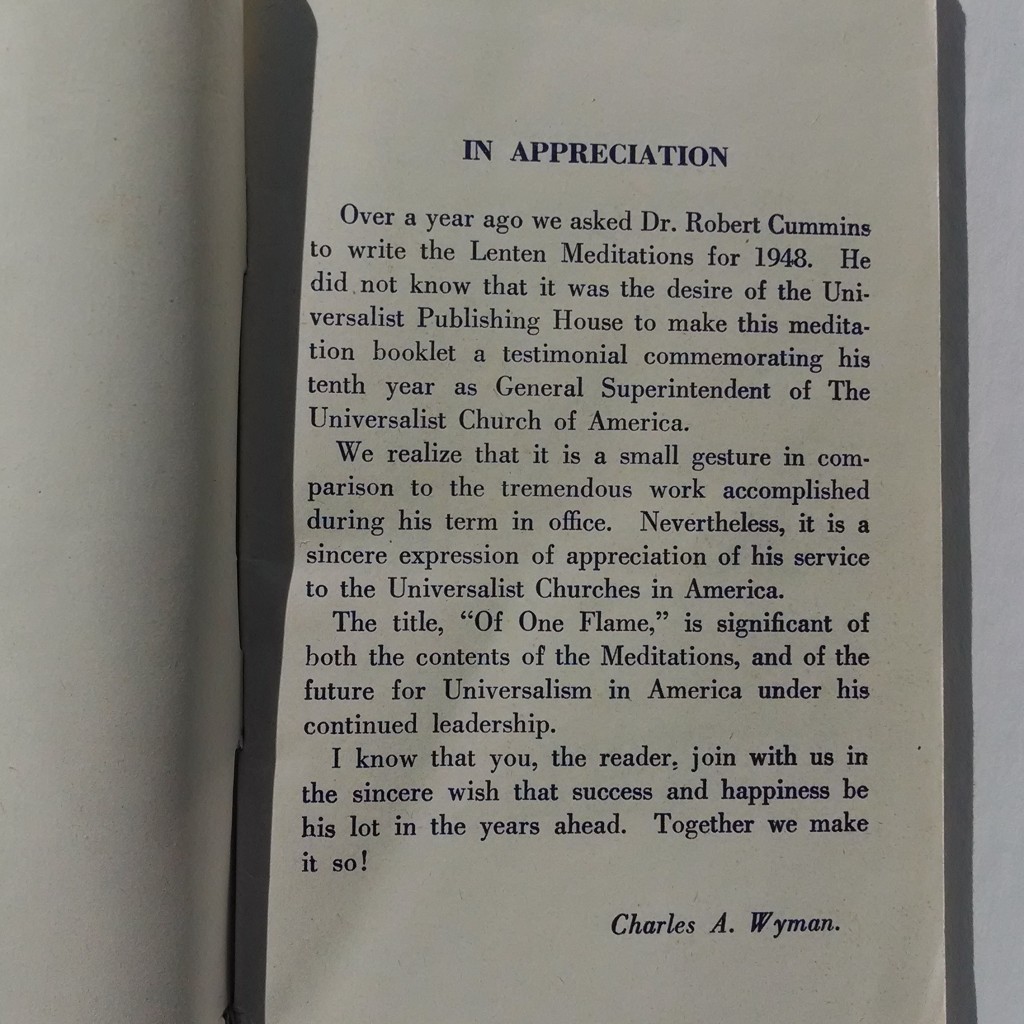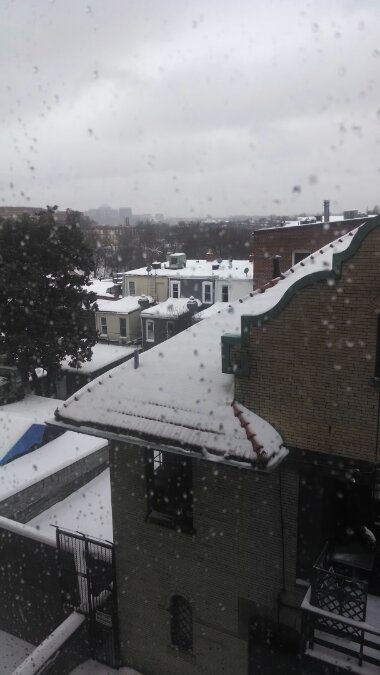This is the first part of a (surely long and rambling) series on findings from Universalist records at Harvard Divinity School’s library archives. My thanks to Fran O’Donnell and Jessica Suarez of the Andover-Harvard Theological Library for making my visit possible. I love combing through these Hollinger boxes. Evidence of Yankee thrift abounds. Serious business — which today would be shipped by courier or with tracking numbers, or protected with encryption — went by typed postcard. But one of their habits — one I share — revealed some glorious relics. Make old print jobs into scrap paper; the other side has a use you know. So mundane memos preserve scraps of design choices. Here are a couple I caught.
Public-domain off-center cross
With due respect to the designer of the off-center cross here, this one — with thinner lines and a smaller cross; I made it about as high as the circle radius — looks more like the ones I’ve seen used by mid-century post-Christian Universalists. Its later, and I think unintentionally ironic, adoption by Christians notwithstanding.
For Universalist Christianity, I’d suggest an anchor or heralding angel as more appropriate, but that’s for later.
In the spirit of the original, I also dedicate these graphic files to the public domain.
The public domain declaration applies to the ready-to-use PNG and the better-for-making-derivative works SVG, downloadable below.
To the extent possible under law, Scott Wells has waived all copyright and related or neighboring rights to off-center-cross_thinner-10px_cross-radius_300px.png. This work is published from: United States.
To the extent possible under law, Scott Wells has waived all copyright and related or neighboring rights to off-center-cross_thinner-10px_cross-radius.svg. This work is published from: United States.
A visit — heck, let's call it a pilgrimage — to Mt. Auburn Cemetery
Mt. Auburn Cemetery is well known as the nation’s first “garden cemetery” which, though now the norm, contrasted with the gloomy church yard or burial ground. But Mt. Auburn does it better than any I’ve seen and there lies the mortal remains of many a famous Universalist and Unitarian.
I joined dear friends, also Unitarian Universalist ministers, Hank Peirce and Adam Tierney-Eliot, there on March 17 to visit a just a couple of luminaries and brave the late-winter ice.

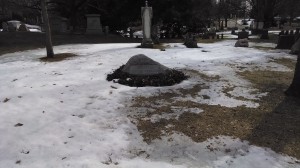


Use Universalist celebrations to flesh out your church year
Even though you occasionally hear about Unitarian or Universalist preachers using a lectionary — indeed, a handful of churches have a well-established lectionary tradition — most UU preaching is topical, with the sermon and other observances hanging off of a holiday. If there is one to be had. Otherwise it’s Preacher’s Choice: which can be magical from a great pulpiteer, but too often the effect is uneven or eccentric.
In which case, it makes sense to rehabilitate the observances commended by the Universalist General Convention generations ago. In any case, it provides an excuse to put an idea on the calendar, and that can be one less blessed thing to think about.
Links refer to prior blog posts on the subject; for Japan Sunday, you might read ICUU or IARF. Presented here are set opportunities for new member welcome or recognition; religious education; child dedication or baptism; remembering the dead in our circles from the last year; the common origins and destiny of humanity; our foreign work; and (well) Christmas.
The observances:
- Easter Sunday: a Service of Recognition be held, “at which time persons baptized in childhood, and others, may be welcomed by suitable rites to membership of the Church.”
- Educational Sunday: the third Sunday of May, “for the presentation to the people of the educational interests of our Church…”
- Children’s Sunday: the second Sunday in June, “that parents and guardians be encouraged and invited to bring their children to the altar on that day for baptism or dedication to the service of the Lord.”
- Memorial Sunday: the first Sunday of October, “for commemorating those friends who, during the year, have been taken away by death.”
- All-Souls Sunday: the first Sunday of November, “for a special celebration of our distinguishing doctrine, the Scriptural truth that all souls are God’s children, and that finally, by His grace attending them, they will all be saved from the power of sin, and will live and reign with Him forever in holiness and happiness.”
- Japan Sunday: the fourth Sunday in November, “for the presentation of the claims of our Foreign Work and for soliciting pecuniary aid therefor.”
- Christmas Sunday: Sunday nearest Christmas, be “observed by appropriate services”
Bleg: inexpensive guest house or hotel near Harvard
Dear readers: A bleg: blog beg. Any ideas for an inexpensive guest house or hotel in Cambridge, Massachusetts near Harvard or Mt. Auburn Cemetery?
I have a day coming where I can look some things up in the Universalist archives, and visit the graves of Hosea Ballou and John Murray. One to satisfy some questions (for later blogging) and the other as a pilgrimage.
No democracy can be real…
No democracy can be real which shuts out half the people. Women should therefore have equal economic, social and political rights with men.
The pew rent system and membership
This is a continuation of the thread on the history of membership in Unitarian and Universalist congregations.
I know the very idea of a fundraising canvass will send many of you into a fit of groaning. But the approach to funding, also known as the voluntary system, is a huge improvement over what came before it: the pew-rent system.
By this I mean raising money for building a meetinghouse and sustaining a minister by selling or renting seats or pews. You can see vestiges in older churches, in the form of engraved plates with names of people long dead. Owned pews were property: they could be inherited or sold. Their use was restricted by their owners, and status-seeking persons could show their social station though high-priced seats up front. Additionally, they could be used as collateral in securing debt. Pew owners, very often hereditary and with no particular interest in a congregation, had been known to sell out meeting house for profit.
The pew-rent system made theological orthodoxy nearly impossible to enforce, even as it reinforced class structures. Thomas Whittemore, in his 1840 The Plain Guide to Universalism, cautions societies to maintain the twinned church–a community of professing believers– with the religious society because
In some cases, especially in Boston, it is impossible to guard the society against the admission of members, whatever their religious opinions may be. For what is a religious society in Boston? It is the proprietors of the meeting-house, the owners of the pews therein. These pews may be transferred from one to another, at the will of the owners; and the purchaser has the full and legal right to attend all the proprietors’ meetings, and vote in all concerns of the corporation, whether he be Christian, Jew, Mahometan, or heathen. The whole business is in the hands of the proprietors of pews, and we suppose, of right, ought to be, not excepting the selection and settlement of the pastor.
But as with other calls to reform, the weight was with the status quo: a practical source for liberality or practical plurality?
But times changed. James Freeman Clarke was the Unitarian first-mover when, also in 1840, he opened in Boston the Church of the Disciples on a “free seat” (voluntary donation) basis. While Universalists came down on both sides of the religious freedom this system brought, its unworkability with its final downfall across all confessions. It was unfair and discouraging to new would-be members. The occasional provision of free seats (in undesirable places) underscored the problem. It set the building up for speculation, and building bubbles bankrupted not a few congregations. And while the idea of collecting rent seems simple enough, there were also complaints that it was impossible to extract them–particularly from absentee landlords–and so money was tight. By the time in 1922, the Christian Register (May 4) published it survey of more than 200 Unitarian parishes, none had anything good to say about the pew ownership or rental, or any number of hybrid variant, systems. The voluntary system was modern, ascendant and lucrative. “Free seats” made better financial sense. Churches in the easy-going West were most likely to use the voluntary system, and churches in New England, where the practice continued the longest, were willing to try something new.
Of course, the pew-rent problem would have solved itself in time. There are usually too few attenders rather than too few pews. Amplification has made more of the meetinghouse accessible to more people. And how many times have the few first pews of a church been taking up–prime real estate–in order to make room for a piano or some other liturgical change? New occasions teach new duties.
All of this goes into our understanding of the running of a religious society; that financial responsibility, however structured, is a valid, perhaps even critical requirement, for full participation.
Ways of organizing churches, including how membership is accorded, come and go. It might surprise my long-time readers to hear that I’m not particularly taken with any given model. (I may have radical views about the relationship between the church and society, but these remain to be revealed.) All I care about is that membership standards are made deliberately, fairly, and with the goal of healthy institutions. Since unintended results may come out of good planning, there must also be a mechanism for adjustment, for the sake of equity.
But what we have is better than what we had, and to God be the glory.
Sources for Unitarian and Universalist membership historical context
Well, my post (“What is it we become a member of?“) seems to have stirred the Walled Internet. Where do you go to know what our Universalist or Unitarian forebears thought membership meant? So long as you don’t confuse the concepts of parish, society and church, you can look to a large, if disjointed, number of resources. And the idea of a meetinghouse being an entity, through trustees, in its own right. I do not intend to exhaust this thought here.
First, I’d look to service books and ministers’ manuals, common after the first third of the nineteenth century. Look for services of opening churches and confirmation, which often includes language about membership. Also, Universalists published meaty apologetic works that often had a polity chapter, so you’d have all you need to start a church. Don’t skip the introductions. Look for model bylaws and constitutions, especially among the Universalists; these are easier to find than the local bylaws, but some can be had. Not just for the church and the parish, but for the (after the 1890s) the recommended unified church-parish. And for the state conventions, and how the concepts of fellowship, obeying laws and assented belief have parallels at the local level. Look to the Universalist professions of faith without knee-jerk anti-credalism, such as the 1899 “Five Principles” which begin “conditions of fellowship in this Convention shall be as follows…”
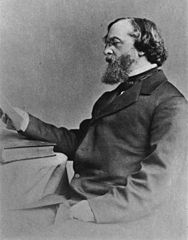
Look to what made certain churches and leaders exceptions, so as to see the rule. The preface of the King’s Chapel prayerbook is, among other things, an ecclesiological document. Investigate James Freeman Clarke‘s Church of the Disciples (I’ll come back to him) and the institutionalism of Universalist Elbridge Gerry Brooks’s “new departure.”
Consider that the law itself has shaped our ecclesiology, even if we don’t talk about it past the Cambridge Platform. There’s the ad-hoc and minimalistic ecclesiology of first generation Universalists. The Dedham Decision, naturally. But also laws that forbade religious congregations from incorporating early on; what was their alternative? (Virginia was the last (PDF) give this up, in 2002.) And the very idea of tax exemption…
There’s more, but that’s enough to digest now.
A Universalist reference to the flaming chalice?
So, historic hashing of prior iterations and influences of the flaming chalice symbol has been going on on Facebook. No place to have a public conversation, so when the “it’s a Unitarian (not Universalist) thing” card got thrown, I knew I had to chime in and thus blog about it.
I’m no fan of the flaming chalice symbol, and so I’ve kept this tidbit to myself. Years ago, back when I still lived in Georgia, the widow of a former Universalist minister sought me out to receive some of her husband’s collection of Universalist ephemera.
In it was this Lenten meditation manual from 1948.
In case you don’t recognize the author’s name and want proof of its Universalist provenance.
Oh, and lookie there, as I read on. No copyright notice. It’s fallen into the public domain. Might have to do something with that.









